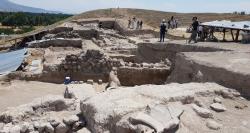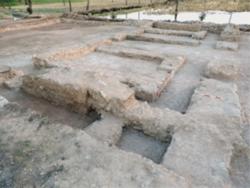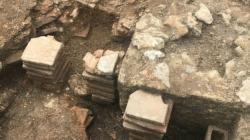INSTITUT SUPERIEUR D'ANTHROPOLOGIE
INSTITUTE OF ANTHROPOLOGY
ONLINE COURSES / COURS A DISTANCE
SUMMER TERM : JULY 2018
REGISTER NOW
GRECE –  Episkopi - A tomb of a prominent woman came to light in Episkopi, Sikinos, during the restoration work of the Episkopi Monument that the Ministry of Culture and Sports has carried out along with the Ephorate of Antiquities of Cyclades since 2017. “The wealth of jewelry worn by the woman betrays that she was a prominent figure in Sikinos society,” the Culture Ministry said in an announcement. Archaeologists gathered golden wristbands, rings, a necklace, a buckle with embossed chamomile, along with glass and metal vases, as well as fragments of the costume of the dead,” the announcement said.
Episkopi - A tomb of a prominent woman came to light in Episkopi, Sikinos, during the restoration work of the Episkopi Monument that the Ministry of Culture and Sports has carried out along with the Ephorate of Antiquities of Cyclades since 2017. “The wealth of jewelry worn by the woman betrays that she was a prominent figure in Sikinos society,” the Culture Ministry said in an announcement. Archaeologists gathered golden wristbands, rings, a necklace, a buckle with embossed chamomile, along with glass and metal vases, as well as fragments of the costume of the dead,” the announcement said.
http://greece.greekreporter.com/2018/07/22/%CF%84omb-of-prominent-woman-unearthed-in-greeces-sikinos/
TURQUIE –  Kınık Mound – A Hellenistic era temple which dates back to more than 2,000 years has been unearthed in archeological excavations in central Turkey. The 2,100-year-old temple was found in Kınık Mound, an archeological site located in Yeşilyurt village of Altunhisar district, Niğde province. A team of Turkish and Italian archaeologists has been working in the site since 2011. In 2016, a 2,500-year-old temple dating back to the late Persian era had been discovered at the same site. Professor Lorenzo D'Alfonso, a New York University academic and head of the excavations, affirmed the temple dated back to Hellenistic time. "We continued excavations just below the place where we found the temple, and we found another temple dating back to the Hellenistic period, 2,100 years ago," D'Alfonso told Anadolu Agency on Saturday. D'Alfonso said that Kınık Mound likely hosted no city or settlement since 30 B.C.
Kınık Mound – A Hellenistic era temple which dates back to more than 2,000 years has been unearthed in archeological excavations in central Turkey. The 2,100-year-old temple was found in Kınık Mound, an archeological site located in Yeşilyurt village of Altunhisar district, Niğde province. A team of Turkish and Italian archaeologists has been working in the site since 2011. In 2016, a 2,500-year-old temple dating back to the late Persian era had been discovered at the same site. Professor Lorenzo D'Alfonso, a New York University academic and head of the excavations, affirmed the temple dated back to Hellenistic time. "We continued excavations just below the place where we found the temple, and we found another temple dating back to the Hellenistic period, 2,100 years ago," D'Alfonso told Anadolu Agency on Saturday. D'Alfonso said that Kınık Mound likely hosted no city or settlement since 30 B.C.
https://www.dailysabah.com/turkey/2018/07/22/ancient-hellenistic-temple-unearthed-in-central-turkey
ROYAUME UNI – Sedgeford - Archaeologists at Sedgeford have discovered a 1,200-year-old Anglo-Saxon malthouse buried for hundreds of years by soil washed down from surrounding higher ground. It is the first time that a complete start-to-finish malting process from that period has been discovered in Great Britain. The presence on the site of a mass of Ipswich Ware pottery made between 720-850AD, effectively dates the period during which the malthouse was operative. It was a sophisticated production line which showed the settlement on the Heacham River, was not as primitive as is popularly supposed. The settlement was Christian and it is believed the malt house was not something organised by the local inhabitants but was part of a much wider integrated system. The technology of malting employed on the site is very similar to that done today by traditional maltsters said Dr Jolleys. The barley was steeped in a pit of water, probably in a sack, starting a germination process which continued when spread out on the clay floor until the starch in the grain has mostly changed into sugar, called maltose, before being stopped by heat from a kiln. The malt was then distributed to local brewers who made the beer.
https://www.lynnnews.co.uk/news/anglo-saxon-malthouse-discovered-at-sedgeford-dig-9004507/
TURQUIE –  Tripolis - Archaeologists in Turkey uncovered a 2,000-year-old villa, decorated with mosaic and fresco in the western province of Denizli, Anadolu Agency reported on Saturday. The head of the excavation team, Bahadır Duman, said that the 12-room villa, that was discovered in Buldan district of Tripolis Ancient City, was ornamented with mosaic, fresco and geometric figures with botanic images. “The first construction phase of this villa with mosaic ornamentation starts in the late Hellenistic period. We can say that the first construction phase dates back to 2,000 years,” Duman told Anadolu Agency. According to Duman, the owner of the villa was a merchant in agriculture and the liquids such as perfume and olive oil were stored in the house indicate that the members of the family living there were also trading those items.
Tripolis - Archaeologists in Turkey uncovered a 2,000-year-old villa, decorated with mosaic and fresco in the western province of Denizli, Anadolu Agency reported on Saturday. The head of the excavation team, Bahadır Duman, said that the 12-room villa, that was discovered in Buldan district of Tripolis Ancient City, was ornamented with mosaic, fresco and geometric figures with botanic images. “The first construction phase of this villa with mosaic ornamentation starts in the late Hellenistic period. We can say that the first construction phase dates back to 2,000 years,” Duman told Anadolu Agency. According to Duman, the owner of the villa was a merchant in agriculture and the liquids such as perfume and olive oil were stored in the house indicate that the members of the family living there were also trading those items.
https://ahvalnews.com/turkey/2000-year-old-villa-unearthed-west-turkey
IRAN –  Qasre Shirin - The Public Relations Office of the Research Institute of Cultural Heritage and Tourism (RICHT) quoted Yussef Moradi, head of the team for the fifth archeological exploration season in Khosrow Mansion in Qasre Shirin, as saying that the discovered house in the Khosrow Mansion consists of a central courtyard, a backyard, a veranda, a collection of different living rooms with different dimensions, a kitchen and a storage. According to him, parts of the house, including the veranda, are decorated with plaster plates, having geometric and plant decorations. Referring to the focus of the present season of archeological explorations in the northern side of the building, he added: “Exploration in this section would provide us with valuable information on the private residence of the ruler and his family.” Moradi in continuation referred to the location of the building known as Khosrow Mansion in Qasre Shirin on the northern margin of the current city of Qasr Shirin and along the very important road of Greater Khorasan to Baghdad and said the aforementioned building has a rectangular plan with a length of 360 and a width of 220 meters which has been built on the east-west orientation with a height of six meters. He went on to say that the materials used in this building include river rubbles, brick and plaster mortar and around the veranda there is a collection of rooms and large corridors that are covered with arched ceiling. The archeologist pointed to the existence of construction units on top of the veranda, which consist of two formal or ceremonial sections and a private sector.
Qasre Shirin - The Public Relations Office of the Research Institute of Cultural Heritage and Tourism (RICHT) quoted Yussef Moradi, head of the team for the fifth archeological exploration season in Khosrow Mansion in Qasre Shirin, as saying that the discovered house in the Khosrow Mansion consists of a central courtyard, a backyard, a veranda, a collection of different living rooms with different dimensions, a kitchen and a storage. According to him, parts of the house, including the veranda, are decorated with plaster plates, having geometric and plant decorations. Referring to the focus of the present season of archeological explorations in the northern side of the building, he added: “Exploration in this section would provide us with valuable information on the private residence of the ruler and his family.” Moradi in continuation referred to the location of the building known as Khosrow Mansion in Qasre Shirin on the northern margin of the current city of Qasr Shirin and along the very important road of Greater Khorasan to Baghdad and said the aforementioned building has a rectangular plan with a length of 360 and a width of 220 meters which has been built on the east-west orientation with a height of six meters. He went on to say that the materials used in this building include river rubbles, brick and plaster mortar and around the veranda there is a collection of rooms and large corridors that are covered with arched ceiling. The archeologist pointed to the existence of construction units on top of the veranda, which consist of two formal or ceremonial sections and a private sector.
http://www.irna.ir/en/News/82977265
ROYAUME UNI –  Chichester - The remains of a hot tub big enough to hold four people have been uncovered by archaeologists in Chichester. After the remains of three near-complete Roman buildings were found under Priory Park last year, experts suspected they would find a bath house. A first dig at the park in West Sussex last year confirmed the theory. A second dig has now uncovered what experts have described as a "luxurious tub made from mortar, tiles and bricks". The section uncovered was at first thought to be part of the roof which had collapsed into the heating system - but the dig this summer revealed the fragments to be part of the hot tub. The council believes the bath house to be of "national importance" because of the unusually good condition of the buildings under the park.
Chichester - The remains of a hot tub big enough to hold four people have been uncovered by archaeologists in Chichester. After the remains of three near-complete Roman buildings were found under Priory Park last year, experts suspected they would find a bath house. A first dig at the park in West Sussex last year confirmed the theory. A second dig has now uncovered what experts have described as a "luxurious tub made from mortar, tiles and bricks". The section uncovered was at first thought to be part of the roof which had collapsed into the heating system - but the dig this summer revealed the fragments to be part of the hot tub. The council believes the bath house to be of "national importance" because of the unusually good condition of the buildings under the park.
https://www.bbc.co.uk/news/uk-england-sussex-44910675
CHINE - Sanmenxia - Excavators in central China's Henan Province have found 504 spade coins dating back more than 2,000 years. The coins, unearthed at a construction site in Sanmenxia City, date back to the mid to late Spring and Autumn Period (771 B.C.- 476 B.C.), according to researchers from the local museum. The coins were preserved in a clay pottery cooker. Of the total 504 coins, 434 remained intact, researchers said. Archeologists found no sign of ancient tombs in the excavation site. "It is rare to see such a large number of the coins so well preserved," said Li Shuqian, head of the local museum, adding that the discovery will be significant for studying China's history of currency. Spade coins were an early form of currency used during the Zhou Dynasty of China (1045 B.C. to 256 B.C.). They are shaped like a spade or weeding tool. The coins were abolished after Emperor Qin Shihuang unified the currency in the country in 221 B.C.
http://www.xinhuanet.com/english/2018-07/21/c_137339514.htm
CANADA –  Montréal - Encouraged by the discovery of a 13th century Iroquois village beneath busy downtown streets, archaeologists plan to continue their search for evidence of the elusive Hochelaga settlement on the island of Montreal. They found the remains of a pre-colonial Iroquois settlement that showed some signs of being the remains of Hochelaga village: the thriving, fortified farming hub encountered by Jacques Cartier when he first sailed down the St. Lawrence in 1535. Among the artifacts uncovered at the site were thousands of pieces of pottery, ceramic pipes, stone tools, and a beluga tooth. But the village, while large, isn’t Hochelaga. The artifacts are too old according to Christian Gates St-Pierre, an archeologist at the Université de Montréal: they date back to the 13th century or earlier, at least 100 years before Cartier’s voyage. While not directly involved with the discovery of the Sherbrooke site, Gates St-Pierre is still trying to find traces of the elusive Hochelaga settlement. He’s the lead researcher of a team that has been looking for traces of the village across the island of Montreal. According to Cartier’s description, Hochelaga was composed of about 50 longhouses inhabited by 1,000 to 2,000 people. It was protected by an 18-foot-high triple palisade. Outside, the Iroquoians farmed corn, squash and beans, as well as sunflowers. When Cartier returned on his second voyage to the region in 1541, the settlement had disappeared.
Montréal - Encouraged by the discovery of a 13th century Iroquois village beneath busy downtown streets, archaeologists plan to continue their search for evidence of the elusive Hochelaga settlement on the island of Montreal. They found the remains of a pre-colonial Iroquois settlement that showed some signs of being the remains of Hochelaga village: the thriving, fortified farming hub encountered by Jacques Cartier when he first sailed down the St. Lawrence in 1535. Among the artifacts uncovered at the site were thousands of pieces of pottery, ceramic pipes, stone tools, and a beluga tooth. But the village, while large, isn’t Hochelaga. The artifacts are too old according to Christian Gates St-Pierre, an archeologist at the Université de Montréal: they date back to the 13th century or earlier, at least 100 years before Cartier’s voyage. While not directly involved with the discovery of the Sherbrooke site, Gates St-Pierre is still trying to find traces of the elusive Hochelaga settlement. He’s the lead researcher of a team that has been looking for traces of the village across the island of Montreal. According to Cartier’s description, Hochelaga was composed of about 50 longhouses inhabited by 1,000 to 2,000 people. It was protected by an 18-foot-high triple palisade. Outside, the Iroquoians farmed corn, squash and beans, as well as sunflowers. When Cartier returned on his second voyage to the region in 1541, the settlement had disappeared.
https://theprovince.com/news/local-news/archaeologists-intrigued-by-iroquois-village-found-downtown/wcm/6d4e5556-3618-455a-8468-df66eb58df0a